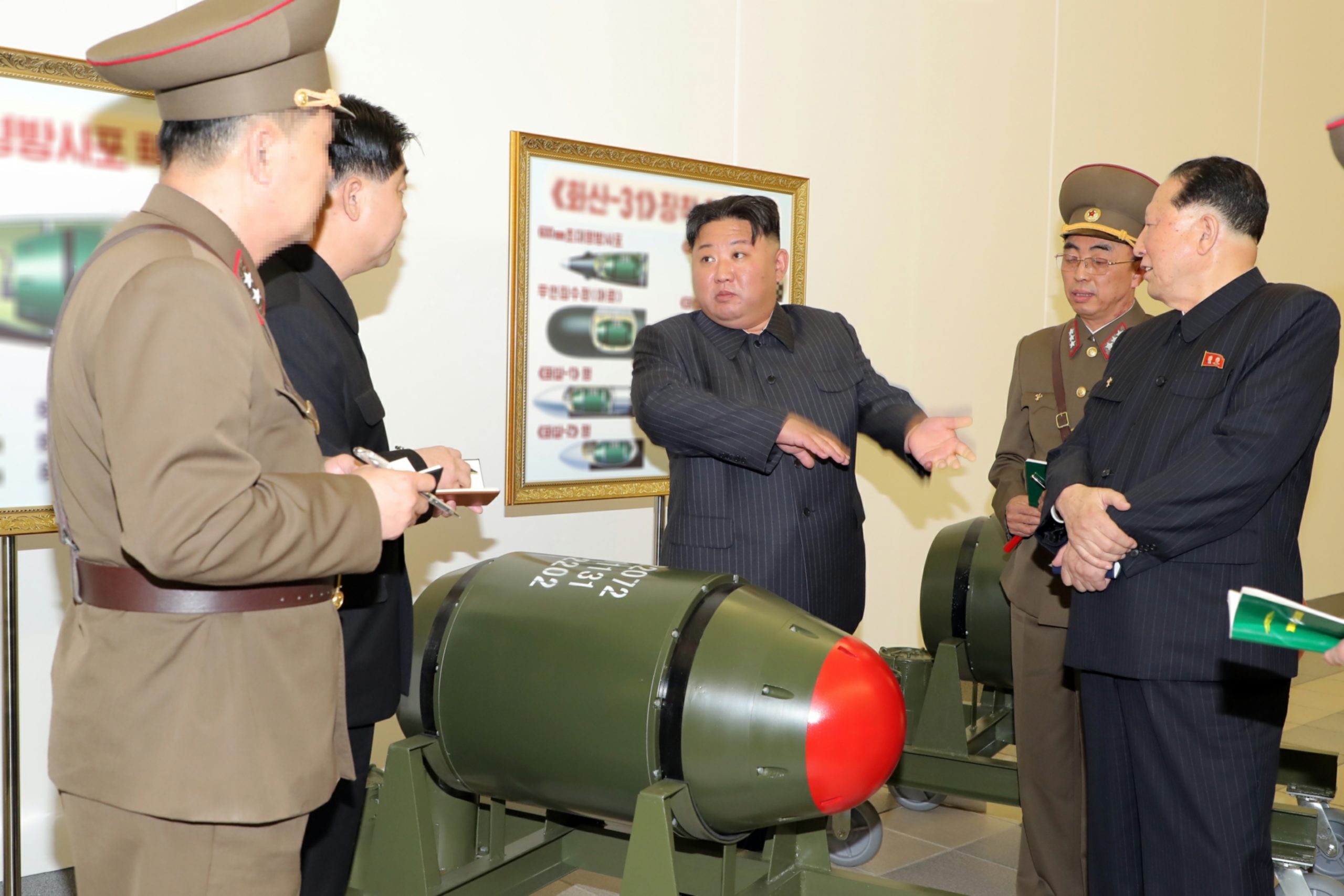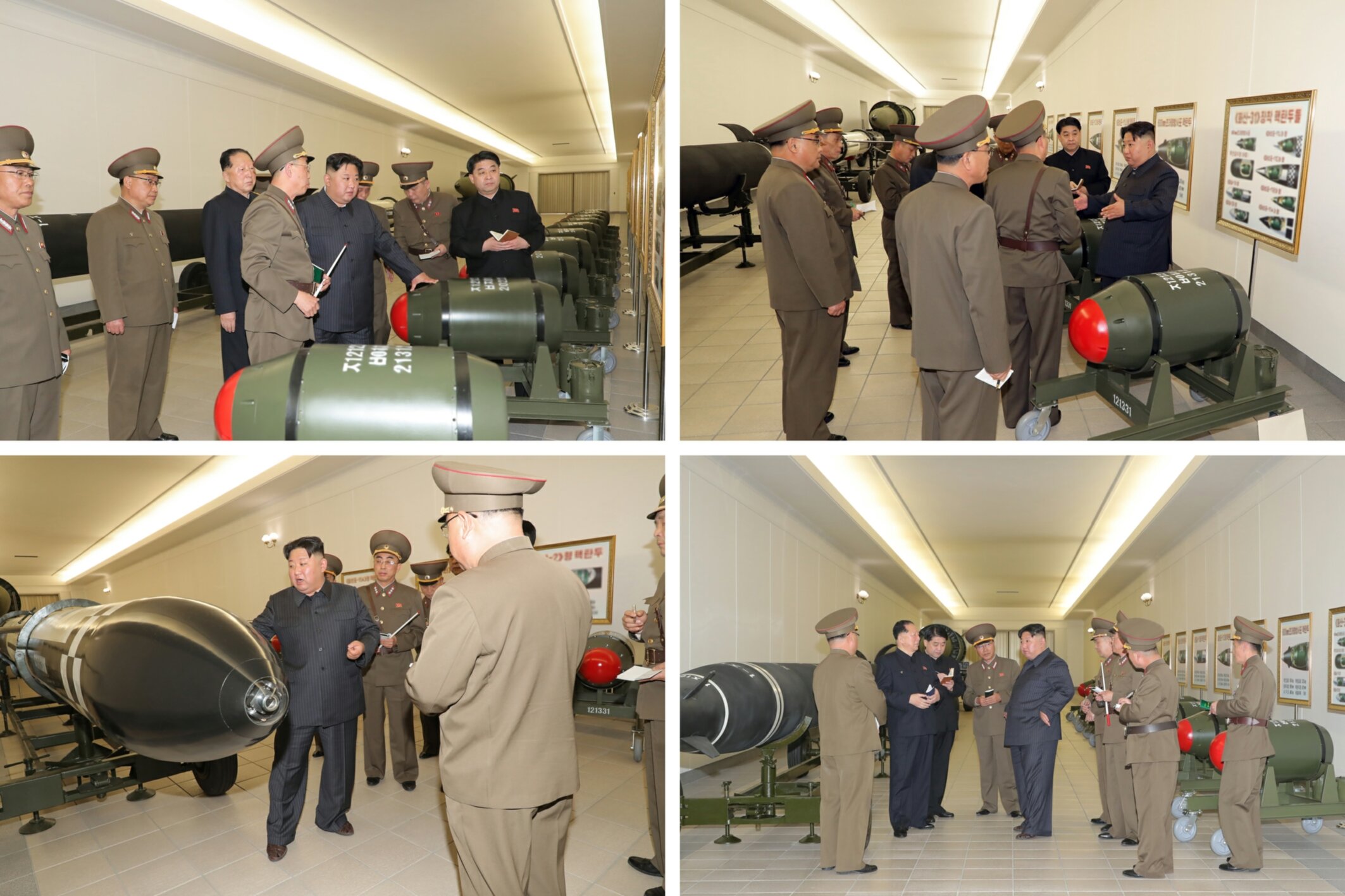March Missile Mania Is Over (and let’s stop predicting #7)

Three events capped off Kim Jong Un’s (Kim Cho’ng-u’n; KJU) March Missile Mania, including his inspection of war heads at the Nuclear Weapons Institute [NWI].
From 25 to 27 March (Saturday through Monday), the DPRK Academy of Defense Science tested what state media identified as an “underwater nuclear attack drone” Haeil-1. The drone left Wo’nsan Bay on 25 March and arrived in Hwadae County, North Hamgyo’ng during the morning of 27 March “after cruising along a jagged and oval course simulating the distance of the 600 km (373 miles) in the East Sea of Korea for 41 hours and 27 minutes.” The test verified that “tactical and technical specifications and underwater navigational and technical indices were correctly estimated and the reliability and safety of the weapon systems.”
On 27 March, a Korean People’s Army [KPA] tactical missile unit’s education company participated in an assembly and command and control drill under the guidance of the Missile General Bureau. Attending the drill were KPA service members and command staff of the relevant sub-units.
The drill included an “examination of the normal operation of the procedures for authentication the nuclear attack order and the launch approval systems” along with a “demonstration education for standard combat action process and handing of equipment for making nuclear assault to the pointed target according to the set procedures and regulations of receiving an order for nuclear attack.” Two ground-to-ground ballistic missiles were loaded with simulated nuclear warheads and a “virtual attack” from Ryokp’o District (Ryokp’o-kuyo’k), Pyongyang, to Kim Ch’aek City, North Hamgyo’ng.”
The unit commander said that the unit’s “mission is clear and we know well about what we should do in contingency affirming that if we fight, we will surely annihilate the enemy.” The officers and service members of the unit “made a firm pledge to uphold the military and strategic plan of the Party Central Committee with the fighting efficiency of a-match-for-a-hundred by increasing the capability of a real war in every way with more fierce and intensive training.”

Meanwhile, on 27 March, Kim Jong Un headed out to the Nuclear Weapons Institute to inspect and guide the work on nuclear warheads. In attendance was Workers’ Party of Korea [WPK] Munitions Industry Department [MID] Senior Deputy Director Hong Sung Mu (Hong Su’ng-mu), MID Deputy Director Kim Jong Sik (Kim Cho’ng-sik), Academy of Defense Science chieftain and ex aequo MID Deputy Director Jang Chang Ha (Chang Chang-ha), along with MID senior cadres and various officials and chief functionaries of the Nuclear Weapons Institute and the Missile General Bureau.
The NWI reported to KJU on its “recent years’ work and production for bolstering up the nuclear force of the DPRK both in quality and quantity in accordance with the orientation of developing nuclear weapons and strategic policy set forth at the 8th Congress of the WPK and 6th Plenary Meeting of the 8th Central Committee of the WPK.” KJU learned about the “means for applying nuclear weapons, technological specifications and features of the structural operation of new tactical nuclear weapons according to the purpose of the operation and targets, interchangeability with different weapons systems, etc.” He also heard about the “work of putting onto an IT basis the state nuclear weapon combined management system ‘Haekbangashoe,” whose scientific accuracy, reliability and security have been strictly verified in the recent combined tactical drill simulating a nuclear counterattack.”
KJU also “examined the plan and written orders for a nuclear counterattack operation” and he “highly appreciated the institute for making its ceaseless efforts in the work to strengthen our nuclear force into the reliable force capable of coping with any nuclear emergency in keeping with the strategic plan and attempt of the Party Central Committee on combining and operating nuclear weapons by different means in the diversified operation spaces, and for making its great achievements.”
With “deep emotion,” Kim Jong Un said that “we have dauntlessly taken a rigorous and long road for possessing nuclear weapons” and he “clarified again that the enemy our nuclear force with poerful deterrence matches are not any state and specific group, but war and nuclear disaster themselves, and the line of our Party on increasing the nuclear force is aimed to defend the eternal security of the state and the regional peace and stability from A to Z.” KJU pointed out that “we should never be satisfied with the work to consolidate the thoroughgoing response posture of our nuclear force and should continuously strive to steadily strengthen the nuclear force.” He remarked that “when we are flawlessly prepared to use nuclear weapons anytime and anywhere, nuclear weapons would not be used forever, and if the powerful and superior nuclear force going beyond imagination is ready for an offensive posture then the enemy would fear us and not dare to provoke our state sovereignty, system and people.”
KJU noted that the NWI “and the field of atomic energy should expand on a far-sighted way the production of weapons-grade nuclear materials for thoroughly implementing the plan of the Party Central Committee on increasing nuclear arsenals exponentially and put spurs to continuing to produce powerful nuclear weapons.” He issued instructions to the NWI and the wider atomic energy sector. According to DPRK state media, the NWI’s scientists and managers, having been given KJU’s guidance, “made a resolution of burning loyalty to always remain loyal to the important mission assigned by the Party and revolution, the country and its people, to produce power nuclear weapons as befitting the reliable ‘nuclear combatants’ of our Party and thus stoutly defense the sacred cause of the Chuch’e revolution.”

Lucky Number Seven
North Korea’s missile mania this month has bought us tickets to the theater of the absurd in which Pyongyang watchers prognosticate the country’s 7th nuclear test any day now. It can not be determined if these people have money riding on the next test happening (does Paddy Power take action on WMD testing?) or if this is a matter of pride, ego and analytical bragging rights. By golly, maybe some outside the DPRK want #7 to happen sooner than the folks at MID.
The DPRK’s seventh nuclear test could happen tomorrow, or it could happen months, if not years, from now. Immediate predictions about the seventh test came after the 8th Party Congress in January 2021. So maybe, Pyongyang will get one or two nuclear tests in before the convocation of the 9th Party Congress in 2026, a little under three years from now. Second wave of #7 predictions came in April and May 2022 when excerpts of a USG assessment made the media rounds. This was followed by satellite imagery analysis in early May which found that repair and renovation work at the P’unggye-ri Nuclear Test Site was sufficient enough for a seventh test to go forward.
Since about May 2022, pronouncements and predictions about the 7th test have been a bi-weekly/monthly affair. But we are waiting for Godot. Perhaps North Korea’s ambitious and aggressive schedule of missile drills and tests during the first quarter of 2023 coupled with the US-ROK joint exercises is feeding the current analytical exuberance. The justifications for carrying out a seventh test are based on technical analyses and assessments. Yoon Sukjoon has a concise list for Pyongyang’s justification for further nuclear testing on technical grounds.
Aside from inflating media and analytical trial balloons there is no one, overarching reason for North Korea to conduct its 7th nuclear test during the first (or second) half of 2023. Outside observers and analysts have barely a keyhole view into the nuclear program’s overall state of development and progress. Even if state media furnished a few more photos, we would remain unaware of the regime’s desired outcomes and various technical benchmarks. The core leadership must have a degree of confidence in the current state of North Korean nuclear weapons as KJU’s visit to the NWI alludes to mass production and ballistic missile events during 2023 are more often described as “drills” (meaning deployment or eventual deployment of weapons to active KPA units) than test activity. It doesn’t matter if these things work or not, Pyongyang is feeding perceptions and , besides, they can upgrade their current inventory. At last check, senior officials of the DPRK defense industry need only satisfy KJU and core elites, not the pronouncements and desires of analysts in Seoul and Washington.
Between announcing war head production for tactical nukes, the steady schedule of ballistic missile drills, C2 drills, testing new weapons systems, expansion work at Nyo’ngbyo’n and the promulgation of the Nuclear Forces Law by the SPA in September 2022, the nuclear weapons program has a lot going for it. This is enough forward progress for KJU to claim to the few core elites to whom he has to justify himself, to DPRK citizens in general and to outside observers, all without having to do #7.
View Original Article